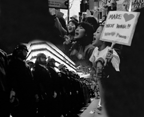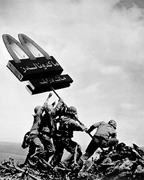Internet Activism
Anti-war sentiments like those seen in 1968 erupted in 2003, and this spring we witnessed unprecedented events like anti-war demonstrations staged on the same day at sites around the world. Undoubtedly this was the result of messages and images flowing instantly between individuals over the internet on a global level. This section examines these images using several videos that were webcast, and considers the possibilities and limitations of the roles of documentaries, films and images in our increasingly confusing modern society.

Things We Have Discovered through Webcasting
Presenter: Kobayashi Atsushi (Video Act!)
Video Act!, an organization working toward the popularization of independent videos, has been broadcasting anti-war themed images over the internet since the September 11th attacks. It continues to provide instant news reports from independent media—something formerly impossible. Over the past two years, eighteen staff members have been involved in filming, and during the two months of March and April alone broadcast twenty-five items, 118 minutes of footage in total. Video Act! also embarked on the collaborative project Nippon, War, Me, an open call for three-minute video works on the theme of “war,” with a commitment to screen all submitted pieces. This presentation explores problems and issues as well as methods of future expansion discovered in the course of Video Act!’s activities, incorporating examples from overseas and previously unscreened footage.

My Gulf War: Net Activism from the Left, the Right, and Every Other Direction
Presenter: Abé Mark Nornes
Looking at Newsreel, we notice the coincidence of this form of anti-establishment activism with the invention and popularization of lightweight 16mm equipment. With the Afghanistan War and Gulf War II, it is apparent that the internet has come of age. This program examines the current situation in light of lessons from Newsreel and movements past. Coordinator of Media Wars (YIDFF ’91) and 7 Spectres (YIDFF ’95), Nornes will base his analysis from the internet activism that came across his screen in the past two wars, including that of both the left and the right and everything in between.
Newsreel Related Screenings
at Kura Obihachi
Time: 9:30pm, October 12 / 7:00pm, October 15
Great Society
- 17 min / Color / 1967 / Source: Oe Masanori
Produced by Studio M2; directed by Oe Masanori and Marvin Fishman. Using six 16mm projectors to show six films simultaneously, this multi-screen work creates a collage of 1960s American news films to depict the U.S. in the “golden sixties,” from the Kennedy assassination to the arrival of the psychedelic generation, plunging into the quagmire of the Vietnam War before the world is finally dissolved by a hydrogen bomb.
Head Game
- 10 min / Color / 1967 / Source: Oe Masanori
Produced by the Third World Studio. Edited and directed by Oe Masanori. The latter half of the 1960s in the U.S. saw the emergence of Harvard psychology professor Timothy Leary and the arrival of the “new age.” In April 1967 a “be-in” staged in New York City’s Central Park proclaimed the dawning of the psychedelic generation, complete with appearances by Allen Ginsberg and flower children (hippies and yippies).The be-in marched to the United Nations, chanting anti-Vietnam War slogans along the way.
• Yamagata Newsreel! | Birth of Newsreel, 1968 | Women’s Newsreel | Bullet Films | Internet Activism | Newsreel Related Screenings |
